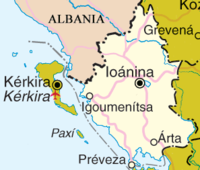| Revision as of 11:49, 16 June 2006 editAldux (talk | contribs)Extended confirmed users27,291 editsm →Demographics← Previous edit | Revision as of 07:27, 17 June 2006 edit undoNeoptolemos (talk | contribs)191 edits People don't identify little or much with a nation. They either do it or not.Next edit → | ||
| Line 27: | Line 27: | ||
| ==Demographics== | ==Demographics== | ||
| Around 350,000 people live in Epirus. According to the 2001 census, it has the lowest population of the 10 ]. This is partly due to the impact of repeated wars in the ] as well as mass ] due to adverse economic conditions. The capital and largest city of the region is ], where nearly a third of the population lives. The great majority of the population are ethnic ], but the province also includes one of Greece's largest concentrations of ]- and ]-speakers, people who |
Around 350,000 people live in Epirus. According to the 2001 census, it has the lowest population of the 10 ]. This is partly due to the impact of repeated wars in the ] as well as mass ] due to adverse economic conditions. The capital and largest city of the region is ], where nearly a third of the population lives. The great majority of the population are ethnic ], but the province also includes one of Greece's largest concentrations of ]- and ]-speakers, people who always identify with the Greek population. Greece does not officially recognize minorities other than the ] in ], therefore it is difficult to estimate the size of the ] and ] minorities. | ||
| ==Geography and ecology== | ==Geography and ecology== | ||
Revision as of 07:27, 17 June 2006
Template:Infobox Peri GR Epirus (Greek: Ήπειρος, Ípiros), is a periphery in northwestern Greece. It borders the peripheries of West Macedonia and Thessaly to the east, Stereá Elláda (Central Greece) to the south, the Ionian Sea and the Ionian Islands to the west and Albania to the north. The province has an area of about 9,200 km² (3,551 square miles). It is part of the wider historical region of Epirus, which overlaps modern Albania and Greece but now mostly lies in Greek territory.
Local government

Epirus is divided into four prefectures (nomoi), which are further subdivided into dēmoi (municipalities) or koinótētes (roughly equivalent to British or Australian shires).
The prefectures are:
Demographics
Around 350,000 people live in Epirus. According to the 2001 census, it has the lowest population of the 10 peripheries of Greece. This is partly due to the impact of repeated wars in the 20th century as well as mass emigration due to adverse economic conditions. The capital and largest city of the region is Ioannina, where nearly a third of the population lives. The great majority of the population are ethnic Greeks, but the province also includes one of Greece's largest concentrations of Aromanian- and Albanian-speakers, people who always identify with the Greek population. Greece does not officially recognize minorities other than the Greek Muslim minority in Thrace, therefore it is difficult to estimate the size of the Aromanian and Albanian minorities.
Geography and ecology

Greek Epirus, like the region as a whole, is rugged and mountainous. It is largely made up of mountainous ridges, part of the Dinaric Alps, that in places reach 2,650 m. In the east, the Pindus Mountains that form the spine of mainland Greece separate Epirus from Macedonia and Thessaly. Most of Epirus lies on the windward side of the Pindus. The winds from the Ionian Sea offer the region more rainfall than any other part of Greece.
The climate of Epirus is mainly alpine. The vegetation is made up mainly of coniferous species. The animal life is especially rich in this area and includes, among other species, bears, wolves, foxes, deer and lynxes.
Economy
Epirus has few resources or industries and its rugged terrain makes agriculture difficult. Tobacco is grown around Ioannina, and there is also some dairy farming and fishing, but most of the area's food must be imported from more fertile regions of Greece.
External links
| Regions of Greece | ||
|---|---|---|
| Regions | ||
| Autonomous regions | ||